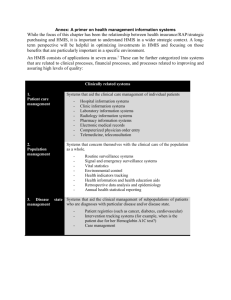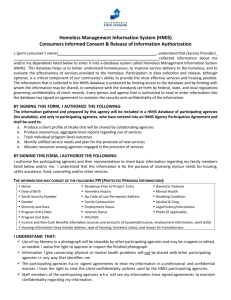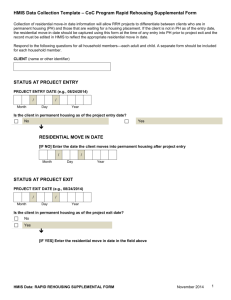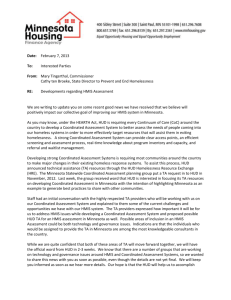HMIS Training - Council of Community Services
advertisement
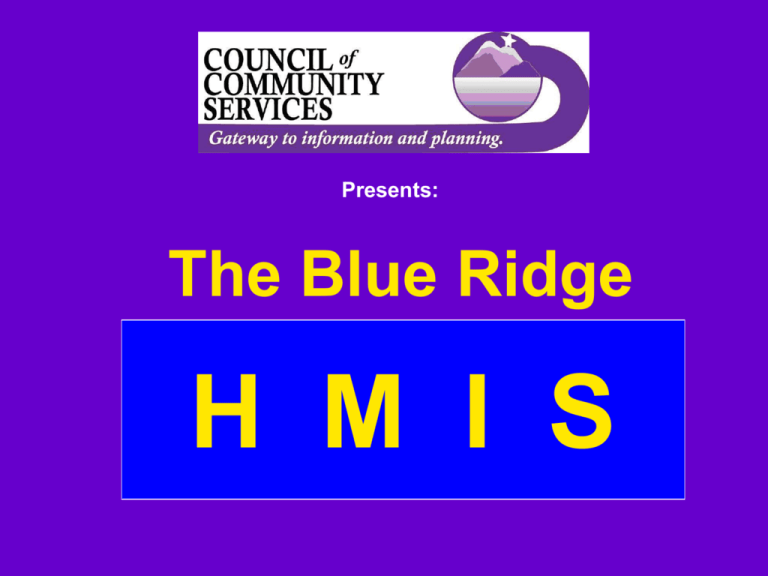
Presents: The Blue Ridge H M I S Overview • What is HMIS? • Benefits of HMIS • Pros and Cons of HMIS • HMIS is a Tool, Not the Goal What is HMIS? Homeless Management Information System • A Homeless Management Information System (HMIS) is a computerized data collection tool specifically designed to capture client-level, system-wide information over time on the characteristics and services needs of men, women, and children experiencing homelessness. • HMIS’s are typically web-based software applications that local homeless communities implement to enter and share client-level data across agencies about homeless persons served in shelters or other homeless service agencies. • HMIS allows the aggregation of client-level data across homeless service agencies to generate unduplicated counts and service patterns of clients served. What is HMIS? … continued • An HMIS is either a vendor developed or a community’s locally developed software system that records and stores information on homeless clients served • HUD’s National Data and Technical Standards establish baseline standards for participation, data collection, privacy and security • Implementation of HMIS is a requirement for receipt of Department of Housing and Urban Development (HUD) McKinney-Vento funding What’s in HMIS? • HMIS records and stores: – Client Intake • Demographics • Basic assessment of needs • Bed utilization – Service Tracking • Services delivered by a provider • Services received by clients • Gaps in the homeless services in a community How can HMIS Help us? • Case Management – Ability to plan, schedule, and follow-up on delivery of services – Ability to track changes in clients over time – Ability to monitor and measure performance goals and outcomes • Information and Referral (I & R) – Database of available resources – Online referrals – Electronic submission of applications for benefits and eligibility determination Triangle of Benefits of HMIS Homeless Men Women and Children Homeless Service Providers CoC Coordinators, Policy Makers, Government Officials Benefits for Homeless Men, Women, and Children • Decrease in duplicate intakes and assessments • Streamlined referrals • Coordinated case management • Mainstream benefit eligibility and/or determination • Professional development through involvement in planning process Benefits for Homeless Service Providers • Improve agency effectiveness through tracking client outcomes • Coordinate services, internally among agency programs, and externally with other providers • Prepare financial and programmatic reports for funders, boards, and other stakeholders • Inform program design decisions Benefits for Community Coordinators, Policy Makers, and Government Officials • Increase understanding of the local extent and scope of homelessness • Facilitate an unduplicated count of persons experiencing homelessness • Identify service gaps (i.e. are the services available meeting the needs of clients) • Inform systems design and policy decisions • Develop a forum for addressing communitywide issues Pros and Cons of HMIS vs. Traditional Methods Why is HMIS a better alternative than point in time counts or aggregate service provider reports for gathering community-wide information on homelessness? • Method: Point in Time Counts – Count everyone who is homeless on one night – Pro: Unduplicated number of people on the street or in shelter in one night, includes those not served by homeless programs – Con: No information on whether those people were homeless for one night or all year. Under-represents those that move in and out of the system throughout a time period Pros and Cons of HMIS vs. Traditional Methods Why is HMIS a better alternative than point in time counts or aggregate service provider reports for gathering community-wide information on homelessness? • Method: Summation of aggregate reports from funded agencies – Each program generates aggregate data about persons served over a time period (i.e. a year) – Pro: Broader information about population served throughout all programs – Con: Duplicated counts, the same people are counted by multiple programs; limited understanding of patterns of service use or total population size. Why HMIS Over Other Methods? Summary of Approaches Method Patterns of Generates Entering and Unduplicated Exiting Counts Homelessness In-Depth Information on Clients and Needs One Night Count Yes No No Service Provider Reports No No Yes HMIS Yes Yes Yes HMIS is a Tool, Not the Goal • What questions can HMIS help to answer: • At the local level? • At the national level? What Questions Can HMIS Answer for Local Communities? • How many people are homeless on the streets and in the service system? • How many are chronically or episodically homeless? • What are the characteristics and service needs of those served? • Which programs are most effective at reducing and ending homelessness? What Questions Can HMIS Answer for the Nation? • How many people are homeless in the United States? • Who is homeless? • Where do people receive shelter and services and where did they live before homelessness? • What are the patterns of homeless residential program use? • What is the nation’s capacity for housing homeless people and how much is utilized? Summary of Key Issues • HMIS Benefits all stakeholders: – Homeless Individuals & Families – Service Providers – CoC, Policy Makers, and Government • HMIS does more than just collect data H M I S Contact the HMIS Coordinator for any questions you may have about the Blue Ridge HMIS. You can reach the HMIS Coordinator at: leeb@councilofcommunityservices.org, Or (540) 985-0131, x703
